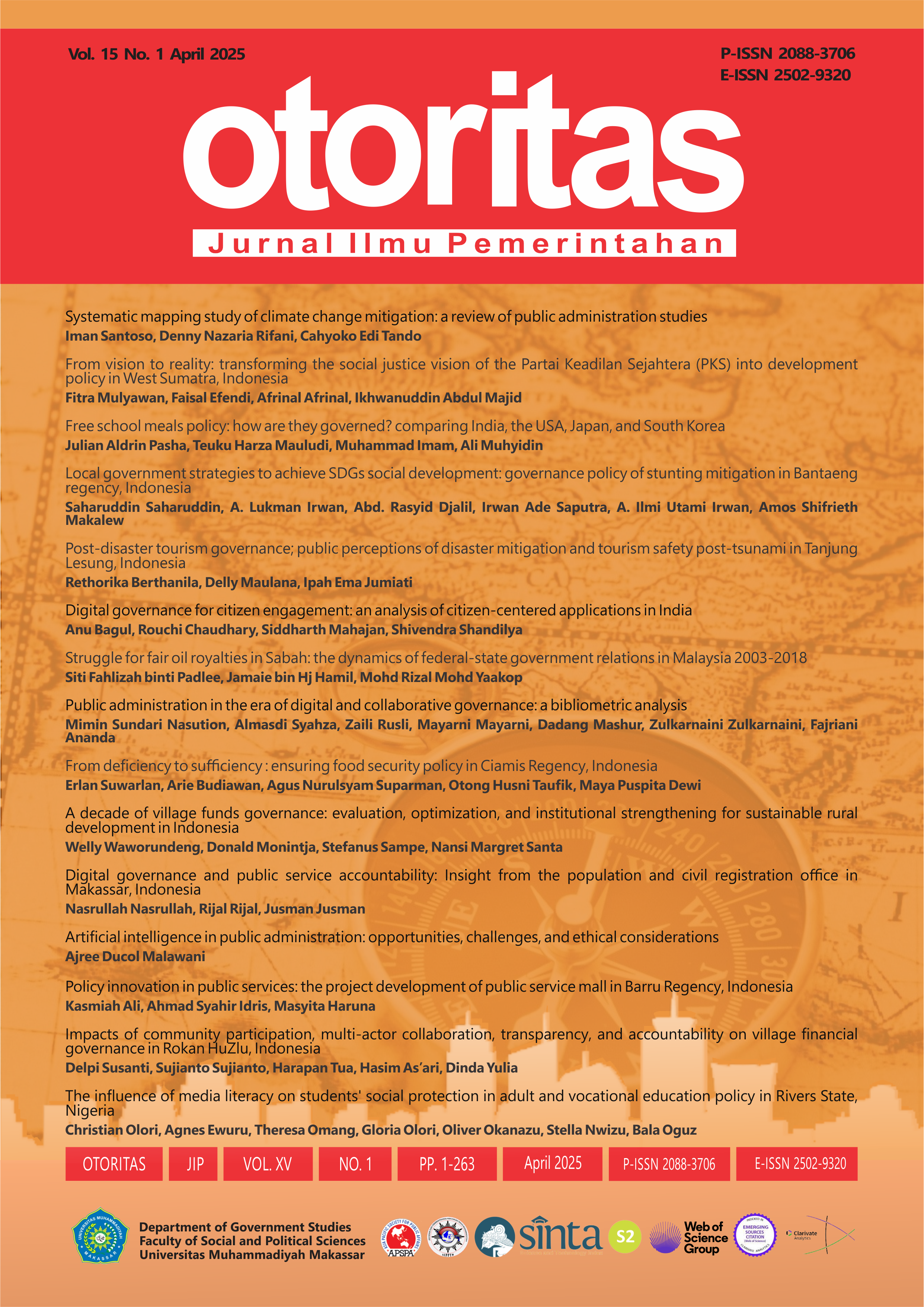Local government strategies to achieve SDGs social development: governance policy of stunting mitigation in Bantaeng regency, Indonesia
DOI:
https://doi.org/10.26618/ojip.v15i1.15123Keywords:
SDGs, policy implementation, stuntingAbstract
Stunting has become a global and national issue in recent years, nationally the government in the 2020-2024 National Medium Term Development Plan targets the stunting prevalence rate in Indonesia to decrease to 14% while Bantaeng Regency sets 14.5 percent where the previous year was 22.1%. Stunting is one of the indicators in the Sustainable Development Goals (SDGs), namely the second goal of ending hunger, achieving food security and good nutrition, and promoting sustainable agriculture. The purpose of this research is to look at the implementation of stunting prevention policies using the SDGs approach, local government strategies, and the challenges of implementing stunting prevention policies using Edwards' theory. This research uses descriptive qualitative research methods through direct interviews with all stakeholders who play a role in stunting prevention, documentation, and direct observation or observation. While the data analysis uses an approach according to (Miles et al., 1994), including data collection, data reduction, data presentation, and drawing conclusions. Based on the researcher's findings that the implementation of stunting prevention policies with the SDGs approach from the economic, social, and environmental aspects, while the local government strategy in overcoming stunting is cooperation between regional apparatus, specific and sensitive interventions, while the challenges of implementing stunting prevention policies include communication, resources, disposition, and bureaucratic structure have been implemented, but are still facing various challenges in all aspects of policy implementation.
References
Abul-Fadl, A. M. A., & Al-Jawaldeh, A. (2022). A Comprehensive Roadmap for Reversing Under-Five Malnutrition on the Arab States Based on the Sustainable Development Goals. Open Journal of Social Sciences, 10(10), 341–358. https://doi.org/10.4236/jss.2022.1010022
Azizah, T. N. (2023). Village Role In Reducing Stunting As An Effort To Achieve The SDGS Of Sukodono Village Sidoarjo District (Vol. 21, Issue 1). Jurnal Administrasi Publik. https://doi.org/https://doi.org/10.30996/dia.v21i01.7935
Beal, T., Tumilowicz, A., Sutrisna, A., Izwardy, D., & Neufeld, L. M. (2018). A review of child stunting determinants in Indonesia. In Maternal and Child Nutrition (Vol. 14, Issue 4). Blackwell Publishing Ltd. https://doi.org/10.1111/mcn.12617
De Onis, M., Blössner, M., & Borghi, E. (2012). Prevalence and trends of stunting among pre-school children, 1990-2020. Public Health Nutrition, 15(1), 142–148. https://doi.org/10.1017/S1368980011001315
Efendy, I., Amirah, A., Nyorong, M., Tanjung, S. M., & Pratama, S. M. (2023). Strengthening the Role of Higher Education in Reducing Stunting Prevention in North Sumatra. Journal of Universal Community Empowerment Provision, 3(2), 42–50. https://doi.org/10.55885/jucep.v3i2.271
Fader, M., Cranmer, C., Lawford, R., & Engel-Cox, J. (2018). Toward an understanding of synergies and trade-offs between water, energy, and food SDG targets. Frontiers in Environmental Science, 6(NOV). https://doi.org/10.3389/fenvs.2018.00112
Firman, A. G. S. (2024). Implementation to accelerate stunting reduction in Sinjai District. In IJOBSOR (Vol. 12, Issue 2). https://doi.org/https://doi.org/10.35335/ijopsor.v12i2.253
Flores-Quispe, M. D. P., Restrepo-Méndez, M. C., Maia, M. F. S., Ferreira, L. Z., & Wehrmeister, F. C. (2019). Trends in socioeconomic inequalities in stunting prevalence in Latin America and the Caribbean countries: Differences between quintiles and deciles. International Journal for Equity in Health, 18(1). https://doi.org/10.1186/s12939-019-1046-7
Galasso, E., Wagstaff, A., Naudeau, S., & Shekar, M. (2016). The Economic Costs of Stunting and How to Reduce Them* Approved for Distribution by Kaushik Basu. https://documents1.worldbank.org/curated/en/099350307142324151/pdf/IDU0e883e26805fcd047b109a050c6013ce72703.pdf
Ginting, K. P., & Pandiangan, A. (2019). Tingkat Kecerdasan Intelegensia Anak Stunting. https://doi.org/https://doi.org/10.37287/jppp.v1i1.25
Glandon, D., Meghani, A., Jessani, N., Qiu, M., & Bennett, S. (2018). Identifying health policy and systems research priorities on multisectoral collaboration for health in low-income and middle-income countries. BMJ Global Health, 3. https://doi.org/10.1136/bmjgh-2018-000970
Grosso, G., Mateo, A., Rangelov, N., Buzeti, T., & Birt, C. (2020). Nutrition in the context of the Sustainable Development Goals. European Journal of Public Health, 30, I19–I23. https://doi.org/10.1093/eurpub/ckaa034
Hendriadi, A., & Ariani, M. (2020). Pengentasan Rumah Tangga Rawan Pangan dan Gizi: Besaran, Penyebab, Dampak, dan Kebijakan. Forum Penelitian Agro Ekonomi, 38(1), 13. https://doi.org/10.21082/fae.v38n1.2020.13-27
Ijaiya, M. A., Anjorin, S., & Uthman, O. A. (2024). Navigating the nutritional paradox: The impact of sustainable development targets on childhood wasting and overweight prevalence. PLOS Global Public Health, 4(6). https://doi.org/10.1371/journal.pgph.0003335
Jasrotia, A., Saxena, V., Bahurupi, Y. A., & Singh, P. (2023). Prevalence of Stunting and its Biosocial Determinants among Young Children Enrolled at Urban Anganwadi Centers in Rishikesh, Uttarakhand. Indian Journal of Community Medicine, 48(6), 873–878. https://doi.org/10.4103/ijcm.ijcm_773_22
Liu, S. (2021). Child Stunting and Land Degradation under the Sustainable Development Goals (SDGs): Evidence from 23 Developing Countries. Land Science, 3(1), p15. https://doi.org/10.30560/ls.v3n1p15
López Secanell, I., Soler Penadés, V., & Renovell Rico, S. (2023). Knowledge about the sustainable development goals of future early childhood education and primary school teachers. EDUCA. Revista Internacional Para La Calidad Educativa, 3(2), 254–274. https://doi.org/10.55040/educa.v3i2.68
Margatot, D. I., & Huriah, T. (2021). The effectiveness of women empowerment in preventing stunting in children aged 6-59 months. Bali Medical Journal, 10(3Special issue), 1230–1234. https://doi.org/10.15562/bmj.v10i3.2852
Martorell, R. (2017). Improved nutrition in the first 1000 days and adult human capital and health. American Journal of Human Biology, 29(2). https://doi.org/10.1002/ajhb.22952
Matthew B. Miles A. Michael Huberman. (1994). Qualitative Data Analysis (Rebecca Holland, Ed.). United Kingdom.
Miles, M. B., Huberman, • A Michael, & Saldaña, J. (1994). Qualitative Data Analysis A Methods Sourcebook Edition.
Mugarura, D., NINSIIMA, H. I., Kinyi, H. wambuyi, Eze, D. E., Tumwesigire, S., Prossy, V., & Andrew, N. (2020). High Prevalence of Stunting in Preschool Children (1-5Years) attending selected Health Centers in a Food Rich Area - Bushenyi District Southwestern Uganda. https://doi.org/10.21203/rs.3.rs-31913/v1
Richter, L., Black, M., Britto, P., Daelmans, B., Desmond, C., Devercelli, A., Dua, T., Fink, G., Heymann, J., Lombardi, J., Lu, C., Naicker, S., & Vargas-Barón, E. (2019). Early childhood development: an imperative for action and measurement at scale. BMJ Global Health, 4(Suppl 4), e001302. https://doi.org/10.1136/bmjgh-2018-001302
Ryan McWay, Pallavi Prabhakar, & Ayo Ellis. (2022). The Impact of Early Childhood Development Interventions on Children’s Health in Developing Countries: A Systematic Review and Meta-analysis. SSRN Electronic Journal. https://doi.org/https://doi.org/10.2139/ssrn.4240945
Sianipar, T. M. E., Nurhasana, R., Hanita, M., & Ayuningtyas, D. (2021). Improving Human Resources as Local Food Processors to Accelerate Stunting Prevention to realize the SDGs: Case Study in Asmat, Papua. IOP Conference Series: Earth and Environmental Science, 940(1). https://doi.org/10.1088/1755-1315/940/1/012095
Siswati, T., Iskandar, S., Pramestuti, N., Raharjo, J., Rubaya, A. K., & Wiratama, B. S. (2022). Drivers of Stunting Reduction in Yogyakarta, Indonesia: A Case Study. International Journal of Environmental Research and Public Health, 19(24). https://doi.org/10.3390/ijerph192416497
Unicef. (2021). The extension of the 2025 Maternal, Infant and Young Child nutrition targets to 2030. http://www.who.int/nutrition/healthygrowthproj/en/index1.html
Van Meter, D. S., & Van Horn, C. E. (1975). The Policy Implementation Process: A Conceptual Framework. Administration & Society, 6(4), 445–488. https://doi.org/10.1177/009539977500600404
Yang, B., Huang, X., Liu, Q., Tang, S., Story, M., Chen, Y., & Zhou, M. (2020). Child nutrition trends over the past two decades and challenges for achieving nutrition SDGs and national targets in China. International Journal of Environmental Research and Public Health, 17(4). https://doi.org/10.3390/ijerph17041129
Downloads
Additional Files
Published
Issue
Section
License
Copyright (c) 2025 Otoritas : Jurnal Ilmu Pemerintahan

This work is licensed under a Creative Commons Attribution-ShareAlike 4.0 International License.
The Editorial Team of Otoritas: Jurnal Ilmu Pemerintahan reserves the right to transfer the copyright of the article once it has been accepted and a decision has been made to publish it.
Department of Government Studies, Faculty of Social and Political Sciences, Universitas Muhammadiyah Makassar in collaboration with Muhammadiyah’s College Association of Government Studies (AIPPTM) and Asia Pacific Society for Public Affairs (APSPA) as the publisher of Otoritas: Jurnal Ilmu Pemerintahan holds the copyright of all articles published in this journal.
The Publisher holds the right to reproduce and distribute the article and author is not allowed to publish the same article published in this journal.
Statement of Authenticity and Manuscript Copyright can be downloaded: here
After filling in the statement letter, please send via e-mail: otoritas@unismuh.ac.id






